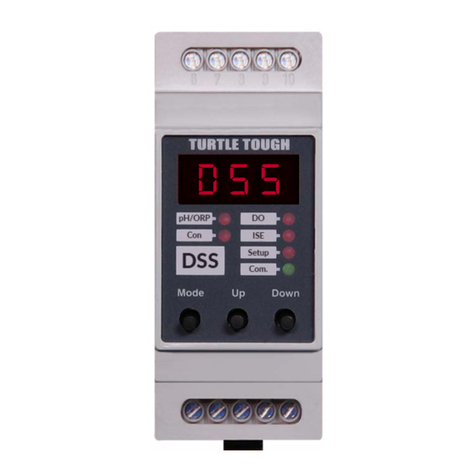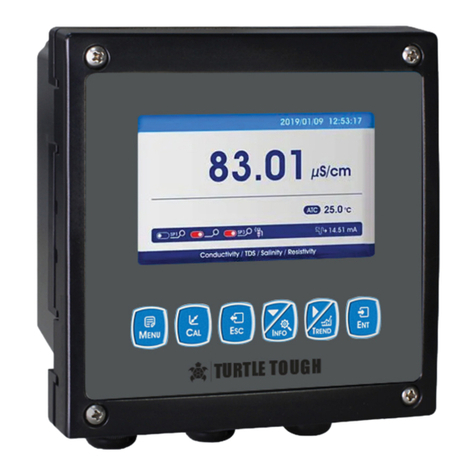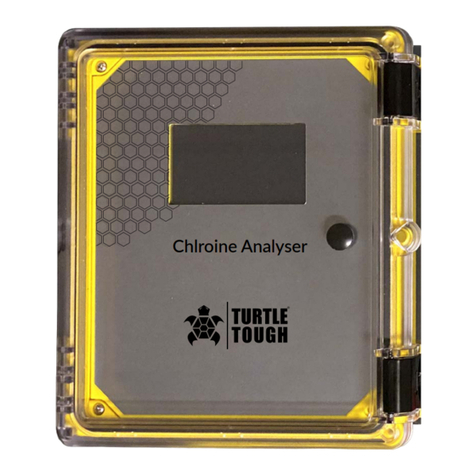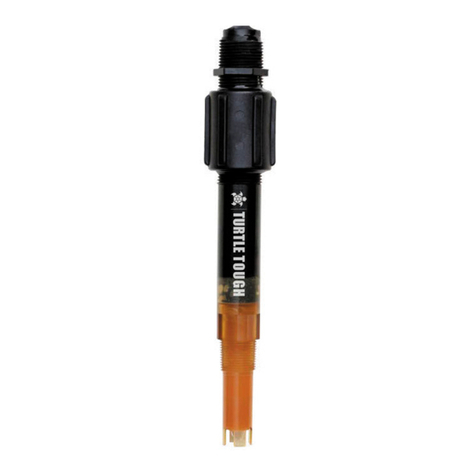
DSS Handheld Field Communicator for Calibraon, Conguraon,
Spot Measurement and Troubleshoong of DSS DO Sensors RS485 Modbus RTU
Led Label Parameter Descripon and Method to Access Range Default
Sensor Type Measurement type Load opons for connected sensor
‘View’ key shows soware revision
pH or ORP or DO or ISE or CON
(autodetected) Per Type
Reading***** Process Parameter****
Display current calibrated value
See Display Features for a detailed
explanaon of how to use this LED mode
0.0 to 150.0 ppm*
0 to 1,500 percent (%) saturaon*
Use ‘View’ key to show % sat
Per
Measured
Soluon
Abs mV / mS Process Parameter Display the absolute mV value from
connector dissolved oxygen sensor
0 to +250 (Negave mV values are not
possible for galvanic DO cell)
Per Sensor
& Media
Cal Temp. Oset calibraon of
temperature in °C **
Adjust temp reading up & down
‘View’ key shows current temp cal. ±25.0 °C * from raw value 0.0
Cal Oset Not Used for DO
Measurements N/A N/A N/A
Cal Slope Denes span (gain) for
DO Sensor **
mV per DO ppm units
‘View’ key shows current slope 0.70 to 6.00 mV per ppm unit 1.60
Dampener Smoothing dampener
& output delay ***
Sets number of seconds to be used
for dampener for process value(s) 1, 2, 3, 4, 5, 8, 10, 15, 20 or 30 Seconds 10- Dampen
1 - Delay
Step Change Sensivity for
‘Up’ & ‘Down’ buons
mV increment for each me the
‘Up’ or ‘Down’ buon is depressed
Choices:
0.05, 0.10, 0.20, 0.5, 1.0 or 2.0 0.10
Special Salinity to compute %
saturaon value
User entered salinity value in PSU to
compute percent (%) saturaon value 0.0 to 50.0 PSU 0.0
Baudrate Sets Baudrate for Com Toggle between 9600 or 19,200 kbps 9600 or 19,200 kbps Per Network
Node Sets Address for Com Chose a valid address on network From 001 to 247 Per Sensor
Item/Serial
Number
Sensor Item Number
and Serial Number
Item # denes model; ‘View’ shows
Serial # (unique traceable idener)
Item # from 1-9,999 with >999
Serial # per DSS Serial Number Scheme Per Sensor
Days in Use Total me DSS sensor
is energised
Increments me in use aer dispatch
from factory to track sensor lifeme
and predicve maintenance purposes
0-65,535 in units of days
(>999 displayed ashing)
Within ±2% accuracy
Per Sensor
Field Use
Max/Min °C Displays max & min
temp in eld use
The max temp in eld use is shown;
Push ‘View’ buon for min temp -40 to +210 °C * Per Sensor
Field Use
* Negave values are always shown as ashing.
Color notes
Parameters in green are dened by factory at dispatch me or determined from eld use.
Parameters in grey can be adjusted as desired.
Parameters in blue are obtained from wet calibraons done with DSS sensor in the eld.
*HFC display maxes out at 99.9 for reading for DO ppm (actual max to 150) and 999 for DO % saturaon (actual max to 1,500)
** Holding the ‘View’ key for 3 to 5 seconds in this LED mode shows the ‘Days in Use’ since this calibraon was performed
** Holding both the ‘View’ and ‘Up’ keys for 3 to 5 seconds in this LED mode will reset all calibraon values back to default
*** Holding the ‘View’ key for 3 to 5 seconds allows for the delay from boot value to be shown as well as adjusted
**** Holding both ‘Up’ & ‘Mode’ keys shows soware rev or both ‘Down’ & ‘Mode’ keys shows build date in Reading LED mode
***** User Adjustable Timeout Feature: Press ‘Down’ + ‘View’ in ‘Reading’ mode to set minutes before automac shuto occurs
Note on Dissolved Oxygen Sensors When Values Are Greater Than 99.9 Ppm Or 999 % Saturaon
When the ppm value exceeds 99.9 it will not be shown (actual max value supported in output is 150ppm). When the computed percent (%)
saturaon value exceeds 999 it will not be shown on display (actual max value supported in output is 1,500%).
Note on DSS Dissolved Oxygen sensor slope calibraon
The DSS Smart Digital Dissolved Oxygen sensors will always have just a single slope and no oset. No oset calibraon is required for the
true galvanic cell since it has a true zero (0mV at 0ppm). The use of just a single slope is possible since the response of the industrial Turtle
tough’s dissolved oxygen (DO) smart digital sensor with Modbus RTU digital output is linear throughout the enre range dened by the mV
per ppm slope calibraon to dene the eecve span.
‘Modbus Com’ & ‘Baery Low’ LED
• The “Modbus Com” LED is illuminated briey each me that a communicaon packet is sent or received.
• The “Baery Low” LED will at rst ash as warning & then illuminate connuously when the 9V baery should be replaced.
o Must change 9V baery when LED is illuminated to ensure valid readings and calibraons.































